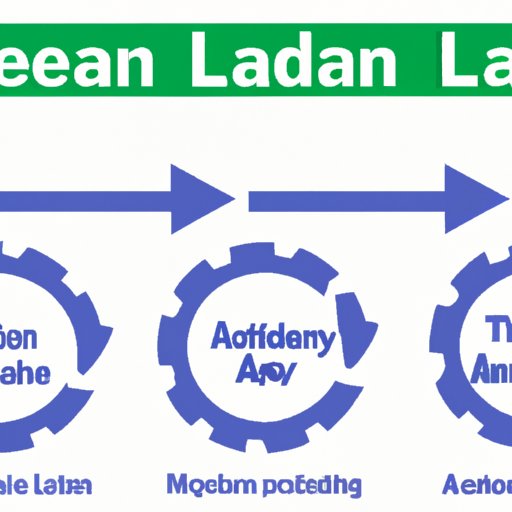Introduction
Lean manufacturing is all about eliminating waste and maximizing efficiency in your business operations. By streamlining processes and creating value for customers, lean principles can help your business reduce costs and increase profits. In this article, we will walk you through the essential steps of mastering lean manufacturing techniques, explore the best practices and strategies, and provide tips and tricks for successfully implementing lean principles in your workplace.
5 Simple Steps to Master Lean Manufacturing Techniques
Here are the five steps you need to follow to master lean manufacturing techniques:
Step 1: Define Value
The first step is to identify what your customers value. Define the needs and desires of your customer base and determine which processes add value to your products and services.
Step 2: Map the Value Stream
Once you know what your customers value, map the flow of your business processes from start to finish. Identify areas where waste and inefficiencies occur.
Step 3: Create Flow
Create a continuous workflow by integrating your processes. Eliminate bottlenecks and interruptions to create smooth transitions between each phase of the process.
Step 4: Implement Pull Systems
Implement pull systems to keep processes flowing smoothly. This involves only producing what your customers need when they need it. By avoiding overproduction and unnecessary storage of excess inventory, you can reduce costs and improve efficiency.
Step 5: Pursue Perfection
Finally, you need to continuously improve and refine your processes. By analyzing your value stream, you can identify and eliminate waste, reduce costs, and improve quality.
The Ultimate Guide to Lean: Best Practices and Strategies
At its core, lean manufacturing is an approach to managing business processes that focuses on reducing waste and maximizing efficiency. Here are some of the best practices and strategies used in lean:
Minimizing Waste
Eliminating waste is the foundation of lean manufacturing. There are eight types of waste that must be identified and eliminated:
- Transportation waste
- Inventory waste
- Motion waste
- Waiting waste
- Overprocessing waste
- Overproduction waste
- Defects waste
- Unused talent waste
Continuous Improvement
Continuous improvement is a fundamental principle of lean manufacturing. By constantly analyzing and refining your processes, you can identify areas that are not adding value and eliminate waste.
5S
5S is a methodology used to improve organization, cleanliness, and efficiency in the workplace. The five S’s stand for:
- Sort
- Straighten
- Shine
- Standardize
- Sustain
Kaizen
Kaizen is a Japanese term that means improvement. It involves making small, incremental improvements to your processes on a continuous basis.
Maximizing Efficiency: Incorporating Lean Principles Into Your Business
Lean principles can be applied to every aspect of your business operations, from production to administration. Here are some examples of how you can incorporate lean principles into your business:
Production
- Minimize setup time by using standardized work procedures
- Implement a pull system to avoid overproduction and minimize inventory waste
- Implement visual management techniques to ensure everyone understands the status of work in progress
- Use mistake-proofing techniques to eliminate defects and reduce waste
Administration
- Streamline approval processes to reduce unnecessary waiting time
- Eliminate unnecessary paperwork and steps in processes
- Standardize processes to improve consistency
- Implement visual management techniques to improve communication and transparency
Lean Manufacturing: Tips and Tricks to Streamline Your Operations
While lean manufacturing can be a game-changer for your business, it can also be challenging to implement. Here are some common mistakes businesses make when trying to implement lean principles:
- Rushing the implementation process without proper planning
- Not involving employees in the process
- Not having a clear understanding of your customers’ needs and priorities
- Focusing only on cost-cutting and not on improving quality
To overcome these challenges and achieve success with lean, here are some tips:
- Take the time to clearly define your value and your customers’ needs
- Involve your employees in the process and listen to their input
- Implement changes in a gradual and controlled manner
- Measure your progress and adjust as necessary
The Art of Lean Production: A Beginner’s Guide
Lean manufacturing has its roots in the Toyota Production System, which was developed in Japan in the 1950s. Here are some key concepts and terminology used in lean:
Muda, Muri, and Mura
Muda refers to any waste in your processes, while muri refers to overburdening your employees or equipment. Mura refers to variations or inconsistencies in your processes.
Takt Time
Takt time is the pace of production that is required to meet customer demand. It takes into account the amount of time available for production and the demand from customers.
Kanban
Kanban is a system used to signal when materials are needed in production. By using visual signals and a pull system, inventory can be kept to a minimum.
Streamlining Your Workflow: Implementing Lean Principles in Your Workplace
Here are some steps for identifying areas of waste in your workflow:
- Create a value stream map of your processes
- Identify areas of waste, such as overproduction, waiting, excess inventory, and defects
- Implement changes to eliminate waste and improve efficiency
To incorporate lean principles into your daily work routine, try the following:
- Evaluate your work processes to identify areas of waste
- Organize your workspace and materials to avoid motion and waiting waste
- Set goals and timelines for tasks to avoid overprocessing and overproduction waste
- Continuously evaluate and refine your processes to eliminate waste and improve efficiency
Conclusion
Lean manufacturing can help your business reduce costs, improve efficiency, and increase profits. By following the five simple steps to mastering lean manufacturing techniques, implementing best practices and strategies, and incorporating lean principles into your workplace, you can streamline your operations and create value for your customers. Start implementing lean principles in your business today to stay ahead of the competition.
